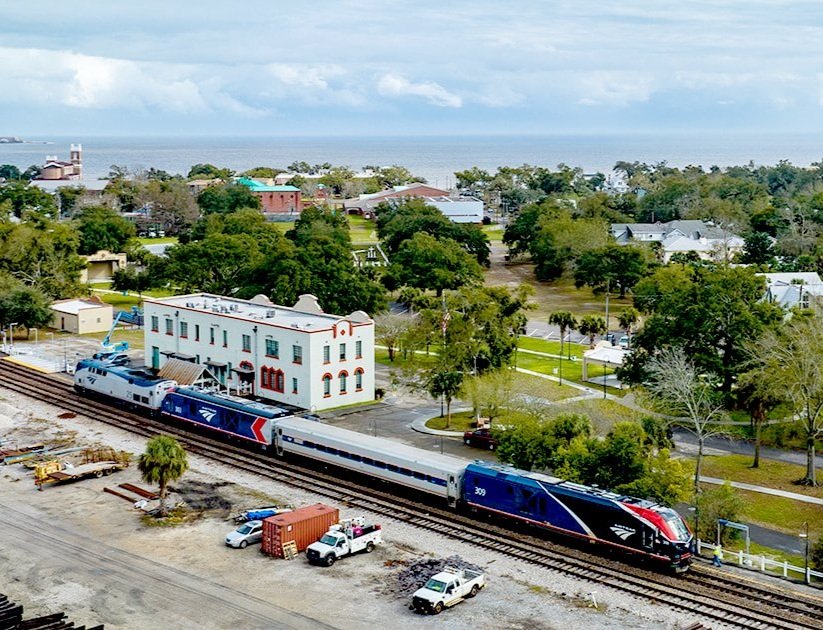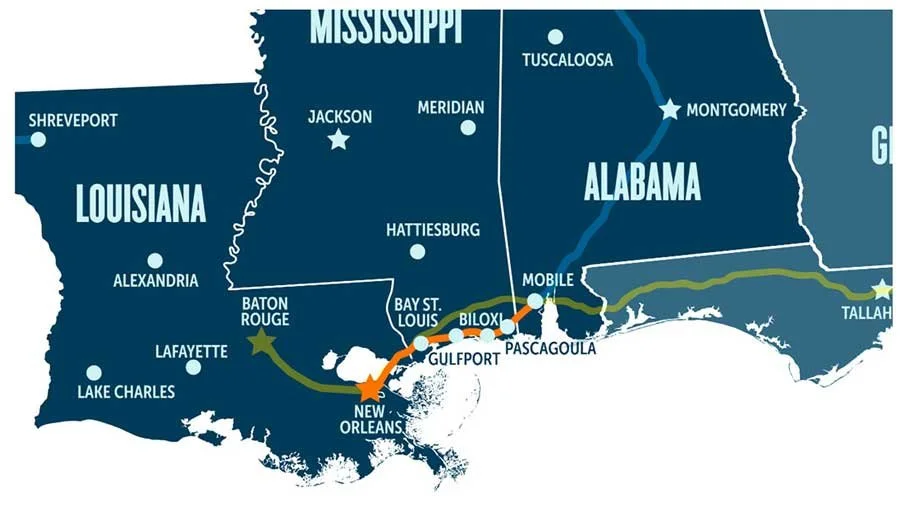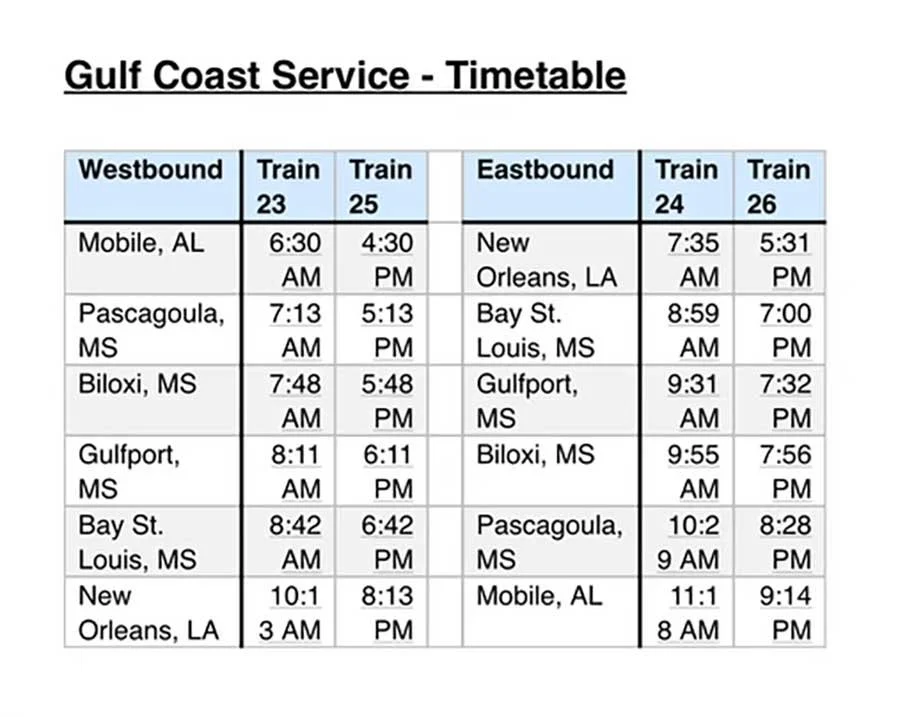Amtrak’s New Orleans to Mobile Line: “We’re Not Giving Up”
An Amtrak familiarization run headed from Mobile to New Orleans passes by the Bay St. Louis depot, photo by Ken Murphy
June 2024Like The Little Engine That Could, it’s been a long and challenging climb for Amtrak supporters working to reestablish passenger service between Mobile and New Orleans. Now, its success – and the fate of a $178 million federal grant that’s tied to it – rests in the hands of the Mobile City Council.
– by Ellis Anderson
The fate of the long-awaited passenger rail service between New Orleans and Mobile – as well as $178 million in federal grant funding to improve rail infrastructure in three states – now seems to hinge on the support of the Mobile City Council.
While efforts to restore Amtrak service on the Gulf Coast have been ongoing since Hurricane Katrina ended service in 2005, many have called the new grant funding a “gamechanger” that has transformed former skeptics into staunch advocates for passenger rail service.
When first announced last September, the Consolidated Rail Infrastructure and Safety Improvement (CRISI) grant was heralded as a boon to both public and industrial transportation. The improvements it paid for would allow the restoration of the long-awaited Amtrak passenger service on the coast. Freight service along that line would also benefit from much-needed upgrading of tracks and crossings.
An Amtrak familiarization run headed from Mobile to New Orleans passes by the Bay St. Louis depot, photo by Ken Murphy
In a celebratory press release issued by Amtrak last September, Senator Roger Wicker (R-MS), long an Amtrak advocate, called the grant a “significant milestone… Restoring passenger rail service will create jobs, improve quality of life and offer a convenient travel option for tourists, contributing to our region’s economic growth and vitality.”
Representative Troy Carter (D-LA) said the grant “ensures the development and construction of vital track and signal improvements, but also emphasizes the importance of maintaining freight service reliability.”
The grant had a few key requirements. Most importantly, passenger rail service had to be restored. Under the plan, morning and evening trains are slated to run from New Orleans to Mobile – and vice versa – for a total of four trains a day. This would allow one-day train trips between the historic sister cities for the first time since the 1960s.
The Amtrak New Orleans to Mobile route will also stop in Bay St. Louis, Gulfport (which is now the second largest city in Mississippi), Biloxi and Pascagoula.
One proposed train schedule
A 20% match is also a grant requirement. Mississippi and Louisiana quickly agreed to pay for the entire match (Lousiana, approximately six million and Mississippi $14 million). According to AL.com, as of January 2024, Alabama had “not contributed monetary support for the project, and it has not been supported by current or past governors,” despite the fact the state stands to receive around $72 million for track infrastructure improvements from the CRISI grant.
In addition to the 20% match – and not tied to the CRISI grant – each state was asked to chip in $3.049 million over three years to help subsidize the passenger line. Louisiana and Mississippi readily complied. But since the state of Alabama declined to participate, the city of Mobile was asked to step up. And they did, in part.
In 2020, the Mobile City Council voted 6 -1 to approve one million toward the subsidy, with hopes that the state would cover the balance. However, no funding was forthcoming from the state and the project stalled for another four years due to other factors.
The train tracks run beneath the sleek Mobile Convention Center, a contemporary 317,000-square-foot facility in downtown Mobile, next to a riverfront park. The new Amtrak passenger platform will be adjacent to the center and a stone’s throw from the National Maritime Museum of the Gulf of Mexico, the Alabama Cruise Ship Terminal – and across the street from the Gulf Coast Exploreum Science Center. Photo by Ellis Anderson.
A view of downtown Mobile from the future platform. In addition to several major hotels within blocks of the platform, there are 55 restaurants and 25 attractions within one mile. Photo by Ellis Anderson.
Since then, three new council members have been elected, and support for the project has shifted. While new council member Corry Penn (District 1), supports Amtrak restoration, as did his predecessor, Ben Reynolds (District 4) and Josh Woods (District 6), have indicated they may be joining the sole 2020 naysayer, Joel Daves (District 5), in opposition.
On June 25, Josh Woods declared that he “doesn’t support the current proposal.” Approval of the subsidy funding requires a majority of five out of seven votes. If Woods indeed votes “no,” the vote will be four to three.
A vote is not on the council’s agenda yet (as of press time) and meanwhile Amtrak allies are working hard to garner support and win over more allies. Mobile Mayor Sandy Stimpson, who was once a doubter himself, is one of those who saw the CRISI grant funding “a game-changer,” He’s now a committed Amtrak fan.
Earlier this month, Mayor Stimpson approached the state for possible assistance. He told the council on June 11 that funding discussions with Governor Kay Ivey’s office have been “warm and supportive” and that “they’re open to exploring options to potentially provide support.”
Stimpson received more substantial backing from the Alabama State Port Authority, which had previously been opposed to sharing freight tracks with passenger trains. Last week, they voted to chip in one million toward the city’s subsidy requirement.
Knox Ross is a longtime member of the Southern Rail Commission. The SRC, created by Congress in 1982, is comprised of members (appointed by governors) of all three states. The commission is charged to “support and influence Southeast rail initiatives.”
The Southern Rail Commission meeting in Mobile on June 7, photo by Ellis Anderson
Ross agrees with Stimpson on the game-changing aspect of the CRISI grant. In a recent interview with FQJ, Ross explained that the grant is critically needed in all three states since few capacity improvements have taken place on that line in 40 or 50 years. In the meantime, freight train traffic has changed: there are fewer trains, but they’re longer.
Much of the new grant funding will go to building more second track infrastructure in Alabama, preventing trains from having to sit and wait while another long one passes. So while the second tracks are necessary for the new passenger trains, they also will make freight traffic much more efficient.
“It’s a great deal for Alabama,” said Knox. “It brings their lines up to the 21st century. And the port’s working very hard to expand their container traffic and so this [the infrastructure improvements] opens up capacity for them. It’s absolutely a win-win for everybody.”
But the win-win isn’t apparent to everyone – which is why community activist Bryan Fuenmayor and a grassroots group of more than 700 members called “the Friends of Amtrak - Mobile, Alabama (FOAMA) are working on a public awareness campaign.
“We’re working hard to educate local voters about what’s at stake,” Fuenmayor said. The group is growing very rapidly and a recent sign-up form for calls to action immediately netted more than 100 volunteers. They’ve created a flyer and are also launching a website soon, www.mobileforamtrak.org.
Fuenmayor became a rail convert on a trip to Europe several years ago. He easily reels off a long list of possible Amtrak benefits.
“I think it will help increase tourism and tax revenue, provide more transportation options to people, connect Mobile to the national passenger rail network, reduce carbon emissions, bring new jobs, reduce traffic congestion along I-10, attract and retain residents – especially our youth, and it will improve the Port of Mobile which has a large economic impact on the city.’
“Overall, it will increase the quality of life of Mobile residents – including mine,” said Fuenmayor. “So we’re not giving up.”
FOAMA members aren’t the only ones. On June 27, Mayor Stimpson spoke to the Mobile Chamber, which afterward voted to support the project. And in New Orleans, both business and tourism leaders have expressed enthusiastic support.
New Orleans is currently served by three Amtrak lines now: the City of New Orleans (NO to Chicago), The Crescent (NO to NYC via Atlanta) and The Sunset Limited (NO to LA). The fourth will position it as a major rail hub.
Union Station in New Orleans, photo by Ellis Anderson
Kim Priez, Senior Vice President with New Orleans & Company, noted “The Amtrak expansion with service from New Orleans to Mobile will open up transportation for those who work and visit throughout our region. Visitors to New Orleans will be able to enjoy all that the coast has to offer.”
French Quarter Business Association president Gina Raby agreed. “The new Amtrack service stands to benefit the city, the French Quarter and our Gulf Coast region,” Raby said. “We are hoping that the issues will soon be resolved, so our community ties along the coast and with our sister city, Mobile, will be strengthened.”
Union Station in New Orleans, photo by Ellis Anderson
The Mobile City Council is expected to vote on the funding in 30 - 60 days. They must also sign a lease agreement with Amtrak for the platform site at the foot of Government and Water Streets, next to the Convention Center.
Platforms have already been constructed in the other cities on the route. Mobile’s should take approximately four to six months to build. In the meantime, operating agreements between Amtrak and the three states will be finalized, putting the train start date sometime shortly after the first of the year.
Presuming the Mobile City Council votes “yes.”
A familiarization run at the Gulfport station, photo by Ken Murphy
Knox Ross quickly punctured one misconception that’s been making the rounds, that by voting “yes,” Mobile might be obilgating itself to unknown subsidies in the future.
“There is no obligation for the city to do anything after three years,” Ross said. “They can just not fund it and the train stops. And we [the SRC] have agreed to help the city find other sources of funding.”
“There have been so many delays, a lot of people thought it was never going to happen,” said Ross. “But we’re so very close now. We’re confident that a satisfactory agreement will be reached.”
“It’s not just passenger travel that’s at stake - the railroad is important to our national economy, especially for our port cities like Mobile and New Orleans.”
Your support makes stories like this one possible:











